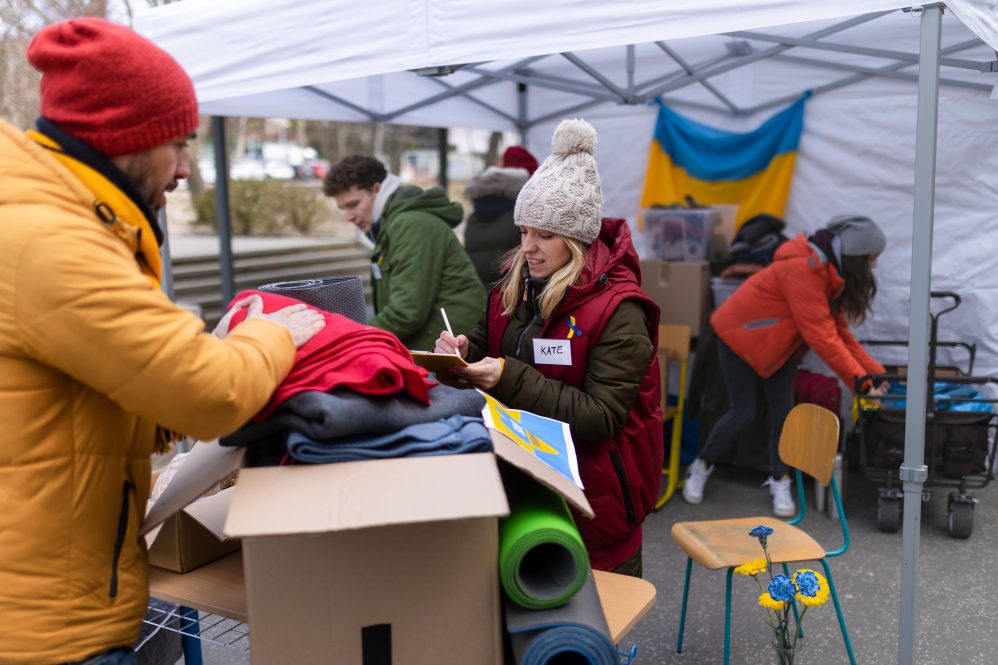When war broke out in Ukraine in February 2022, the number of people forcibly displaced from their home countries around the world was already high. More than 22 million individuals, nearly half under the age of 18, fall under the United Nations’ official mandate as refugees. Though U.S. support for refugees had waned during the Trump administration, a pending policy shift has the potential to increase the number of displaced people who can find a safe haven in U.S. communities.
In a newly published article, associate professor Kathryn Libal and her co-authors, associate professor Scott Harding, and doctoral candidate Madri Hall-Faul, explore the history and impact of different ways to sponsor refugees in the United States. “We assess the re-emergence of community-based approaches to resettle refugees in the United States,” Libal says. Their paper suggests a combination of community and private sponsorship could be transformative for the future of refugee resettlement in the country.
It Takes a Village: Community Sponsorship of Refugees
Historically, the resettlement of refugees in the United States has been managed by individuals and volunteer resettlement agencies, often linked to faith organizations. In 1980, Congress passed the Refugee Act, which formalized the process, establishing a federal program, standards, and funding to support resettlement. It also made health and social welfare programs more readily available to refugees who needed them.
As the number of refugees from different parts of the world continued to grow and shift, U.S. officials proposed different models of sponsoring displaced people, including both community and private sponsorship. Today, the Biden administration seeks to reverse the policies that radically reduced the number of refugees admitted to the United States during the Trump presidency, and has signaled that community and private sponsorship will be critical to strengthening U.S. refugee policy.
To understand the benefits and challenges of one model — community sponsorship – Libal, Harding, Hall-Faul, and other research team members, including associate professor S. Megan Berthold and doctoral students Grace Felten and Lukas Champagne, have been conducting interviews with resettlement advocates and volunteers since 2017. They also examined the important role of organizations such as Integrated Refugee & Immigrant Services (IRIS), a Connecticut-based group that provides comprehensive services and support to refugees, in establishing community sponsorship as a viable model.
In 2015, a wave of displaced Syrians fleeing the country’s civil war prompted IRIS to collaborate with faith-based groups that wanted to lend their support. “There was a groundswell of support across the country to help Syrian refugees, and a lot of community members came forward to support their local resettlement agencies,” Libal explains.
There was a groundswell of support across the country to help Syrian refugees, and a lot of community members came forward to support their local resettlement agencies. — Associate Professor Kathryn Libal
To co-sponsor refugees with IRIS, these groups needed to assist resettling families in Connecticut for one year and help refugees find housing, employment, schools, and other services. This form of community co-sponsorship has proved effective, Harding says, because community groups connect refugees who don’t already have family in the United States to community members who help refugees integrate in communities and form social ties to help them find work and become self-sufficient.
In 2019, community sponsorship got a boost when a group of philanthropies formed the Catalyst Fund to support the model across the United States. To date, some 34 local organizations and five resettlement agencies have received Catalyst Fund grants. These co-sponsorship groups are established in cities as far-flung as Seattle, Pittsburgh, and Los Angeles, providing several examples of how to successfully help refugees resettle and begin a new life in U.S. communities.
Private Sponsorship and the Future
During the Trump administration, refugee resettlement was reduced dramatically and there were few opportunities for community groups to sponsor refugees. But in 2016, an influential report by a group of prominent non-governmental organizations promoted the idea of revitalizing private sponsorship to augment government support. In the model proposed in 2016, small groups of individuals can support refugees without the involvement of resettlement organizations. After Donald Trump took office, the advocates for refugee resettlement tabled plans for promoting private sponsorship as a means to resettle more refugees.
This approach was resurrected when President Joe Biden was elected, spurred by both the U.S. withdrawal from Afghanistan and the war in Ukraine. For Afghans, a combination of private, philanthropic, and government actors organized the Sponsor Circles Program. In this model, groups of as few as five individuals can create a sponsor circle to raise funds and help Afghans meet their initial needs for housing and other resources.
More recently, through the Uniting for Ukraine program, a private sponsor can help resettle Ukrainian refugees for up to two years. Similar to the Sponsor Circles, the private sponsor can be a resettlement group, nonprofit or group of individuals. “The idea of direct public involvement became a necessity because of the scale of need and as a result of the restriction of resettlement organizations during the Trump years. Resettlement agencies weren’t going to be able to handle the work all on their own,” says Libal.
But despite these new approaches, it’s not clear that displaced people from these two countries will receive refugee status. Some have been granted humanitarian parole status for up to two years, and yet others arrived with work or student visas.
In addition to the 75,000-85,000 Afghans who have arrived in the United States in the past year and the 100,000 Ukrainians that the Biden Administration has pledged to take in, there were already individuals from other war-torn countries — such as the Democratic Republic of Congo and Myanmar – waiting for years to be resettled, she notes. Less than 1% of all refugees will have the opportunity to resettle permanently in another country during their lifetime.
There is real hope for revitalizing the resettlement program. — Associate Professor Scott Harding
The Biden Administration has offered a federal grant to facilitate public-private partnerships to meet the need of refugees. One risk of the private model, however, is that the federal government could shed responsibility for refugee resettlement. “Those who are advocating for the policy don’t see this as a replacement for the current resettlement program,” Libal notes. “Private sponsorship is something that should be in addition to the existing program.”
The successes of the community model, and re-emergence of the private sponsorship model, raise the opportunity for more refugees to resettle in the United States. “There is real hope for revitalizing the resettlement program,” says Harding, “not only to be able to resettle refugees who may have been waiting for a very long time, but as importantly, increasing the number of refugees able to find permanent homes in the United States.”



